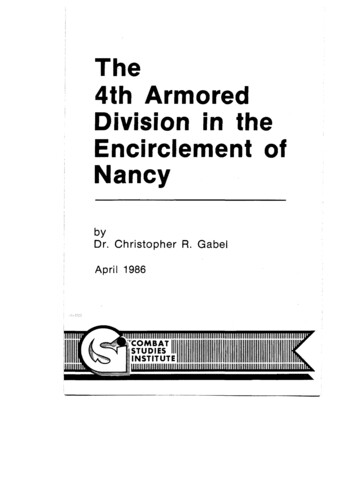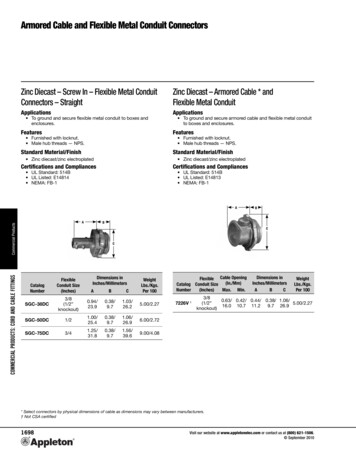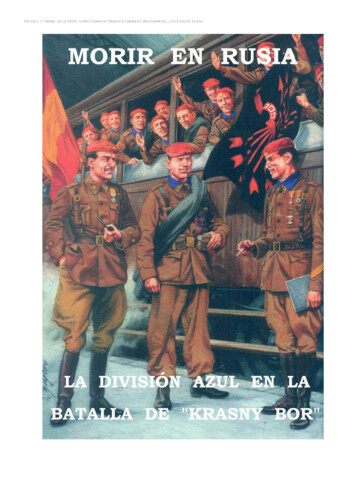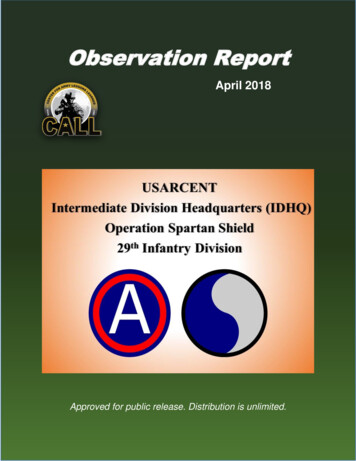
Transcription
The4th ArmoredDivision in theEncirclement ofNancybyDr. ChristopherApril 1986R. GabeE
FOREWORDIn 1944, the 4th Armored Division played a central role inone of the more remarkable campaigns in American militaryhistory-ThirdArmy’s pursuit across France, which was cappedoff by the encirclement and capture of Nancy. In the course ofthis campaign, the 4th Armored Division practiced a mode ofwarfare that has since become known to the Army as AirLandBattle. Inasmuch as the encirclement of Nancy is one of thefew historical examples that shows American mechanized forceswaging war in accordance with the tenets of AirLand Battle,anyone seeking a deeper appreciation of today’s doctrine woulddo well to study this campaign carefully.The 4th Armored Division in the Encirclement of Nancyoriginatedat the U.S. Army Command and General StaffCollege as an introductory class for a course on modern divisionlevel operations. It is a companion piece to The Lorraine Campaign: An Overview, September--December1944, published inFebruary 1985.dLOUIS D, F. FRASCHRColon& InfantryDirector, Combat Studies InstituteCSI publications cover a variety of military history topics. The views expressedin this CSI publication are those of the author and not necessarily those of theDepartment of the Army or the Department of Defense.
rbYDr. ChristopherR. Gabe IApril 1986U.S. Army Command and General Staff CollegeFort Leavenworth,Kansas 66027-6900
Library of Congress Cataloging-in-Publication DataGabel, Christopher R. (Christopher Richard}, 1954The 4th Armored Division in the encirclement of Nancy.“April 1986,”Bibliography: p.1. World War, 1939-1945- Campaigns- France - NancyRegion. 2. United States.Army. Armored Division,4th - History. 3. Nancy Region (France) -History.1. Title. II. Title: Fourth Armored Division in theencirclement of Nancy.94oS4’12’73 88-6om7D762.N28G33 1986
FIGURES1. W.S. armored division,2. Armored division3. Task organization,1944 .attachments1.3CGA, 28 August 1944 .4MAPS1. 4th Armored Division’s pursuit across France,August1944. . .2. The closing of the Lorraine gateway7.,. 93. XII Corps’ plan to enveIop Nancy (modified). . . s . . . . . 114. 4th Armored Division’s encirclement of Nancy,11-14 September 1944 . . . , . , . . . . . . . . . . . . . . . . . . . . , . . . 135. Consolidationof Nancy, E-176. German counterattacks,M-25September 1944 , . *. . . 17September 1944 . . .“. . . . 207. 4th Armored Division’s static defense,26-29 September 1944 . . . . . . . . . . . . I. , . . . . . . . . . . . . . . 228. 4th Armored Division’s operations,lo-29 September 1944 . .l.,.,.I. .111-----24
The Lorraine campaign of 1944 was the most costly andleast productive of the U.S. Third Army’s World War II campaigns. Although the protracted conflict in Lorraine was indecisive, a number of instructive division-level operations took placeduring the fighting. One was the encirclement of Nancy conducted by the 4th Armored Division in September 1944. In onemonth, the 4th concluded an exhilarating pursuit across centralFrance, crossed a major river, performed a classic armored penetration, and consolidated its gains with a skillful active defense.During that one month, the 4th Armored Division vividly illustrated many lessons of division-levelcombined arms warfarethat still apply today.As it was configured in 1944, the 4th Armored Division wasa relatively light, but powerful, formation (see figure 1). Fourteen of the U.S. Army’s sixteen armored divisions, including the4th, each had an aggregate strength of just under 11,000 officersand enlisted men, 263 tanks, and 54 artillery pieces. The division’s major fighting elements were its three tank battalions,three battalions of armored infantry,and three battalions ofarmored field artillery.CCRCCAccsFigure 1.U.S. armoredIASLTEach tankof one companycompanies withmedium tanksdivision,1944battalion within the armored division consistedequipped with M-5 Stuart light tanks and threeM-4 Sherman medium tanks. Both the light andwere fully developed, proven designs with good
2mobility and a favorable power-to-weight ratio and were especially prized for their mechanical reliability. However, the generalpurpose 75mm guns carried by most M-4s and the antiquated37-mm pieces mounted on the Mbs were outclassed by the highvelocity 75-mm and 88-mm guns found on the German tanks ofthe day. Nonetheless, through superior teamwork and tacticalmobility that allowed the Shermans to fire at the flanks andrear of the German tanks from close range, the 4th ArmoredDivision established a favorable kill ratio over German armor.The division’s three field artillery battalions each possessedthree firing batteries armed with the M-7 self-propelled 105mmhowitzer. Even though the M-7 was a hastily improvised designthat carried inadequate armor, it was a highly effective weaponthat combined two superb subsystems: the famous 10Bmm howitzer and the rugged chassis of the versatile Sherman tank.Three rifle companies armed with semiautomatic and automatic weapons made up each of the armored division”s threeinfantry battalions. All the infantry rode to battle in M-3 halftracks, but 1944 doctrine insisted that the riflemen dismount tofight. This was undoubtedly wise, for the half-track carried onlyminimal armor.Other major elements of the armored division were its mechanized cavalry squadron armed with light tanks and darmoredcars, an engineer battalion, and the division trains. In addition,units from corps and army pools were usually attached to thearmored division on a semipermanent basis (see figure 2). Forthe 4th Armored Division, these generally included a tank destroyer battalion armed with M-189 (76-mm self-propelled guns),an antiaircraftartillery battalion, a battalion of 155mm howitzers, three quartermaster truck companies, a quartermaster gasoIine supply company, and an engineer treadway bridge company. Above and beyond these elements drawn from corps andarmy pools, the 4th Armored Division occasionally borrowed oneor more infantry battalions from adjacent infantry divisions.This was because the three organic armored infantry battalionswere often inadequate for the armored division’s needs.The commanding general of the 1944 armored division exercised command and control over the fighting battalions throughthree task force headquarters designated Combat Command A(CCA), Combat Command B (CCB), and Reserve Command.These commands possessed no organic fighting troops of theirown but were allotted the combat and service support assets required to accomplish their individual missions. The CCA and
TRDYBRTRKFigure 2.ArmoreddivisionattachmentsC&3 headquarters each had about twelve officers and eightyenlisted men, enough to provide full staff functions for the combat command. In keeping with its intended role as a nontacticalreserve, the Reserve Command had only three officers and fiveenlisted men. However, in some cases, an armored division commander would upgrade his Reserve Command to a status coequal to a combat command by assigning additionalheadquarters personnel to it. The 4th Armored Division, however,did not do so and, in battle, rarely employed its Reserve Command on independent missions.Unlike some other armored divisions, the 4th never assignedelements to the combat commands on a fixed basis, preferringinstead to retain a high degree of flexibility in its task organization (see figure 3). Typically, however, a combat commandmight consist of one troop from the cavalry reconnaissancesquadron, one or two armored field artillery battalions supplemented with additional 155-mm howitzers, an antiaircraft artillery battery, a tank destroyer company, an engineer company,and combat command trains. These forces would be further subdivided among two or three battalion-sizedcolumns or taskforces, each including tanks, infantry, and artillery and eachcontrolling its own maintenance and supply services. Thus, the4th Armored Division’s technique of task, organization emphasized flexibilityand provided for the close integration of thearms and services at the company, troop, and battery level.--.---
4CCA04TFABRAMS(IMEDIUMFigure 3.Task organization,CCA, 28 August1944The doctrine under which the 4th Armored Division operatedin 1944 cast a rather specific mission for armored forces. According to the 1944 version of FM 17-100, Armored CommandField Manual, The Armored Division:The armored division is organized primarily to perform missionsthat require great mobility and firepower. It is given decisive missions.It is capable of engaging in most forms of combat but its primary roleis in offensive operations against hostile rear areas.1,.,. . .lThe most profitablerole of the armored division is exploitation . . . 2To the 4th Armored Division, these doctrinal tenets weredeepIy engrained articles of faith. It is no exaggeration to saythat the 4th had a distinct personality characterized by aggressiveness and teamwork. As a group, the division believed thatthe 4th’s proper place was deep in the enemy rear. One tankcommander, long accustomed to operating behind German lines,remarked, “They’ve got us surrounded again, the poor bastardsY3To the 4th Armored Division, the primary tank weapon wast.he machine gun, which became the weapon of choice when thedivision engaged in aggressive exploitation and pursuit.The personality of the 4th Armored Division was a true reflection of its commander’s character. Major General John S.
5Wood took over the division in 1942 and trained it for two yearsbefore he led it into battle, This unusually long association between commander and unit fostered a high degree of rapportwithin the division and assured a continuityof effort fromtraining to combat.Wood was known to his contemporaries as “P” Wood, the“P” standing for “Professor.” The distinguished British militaryanalyst Basil H. Liddell Hart once referred to “IX’ Wood as‘“the Rommel of the American armored forces.“* Like the legendary German field marshal, Wood’s superiorsad to restrainhim rather than prod him into action. He preferred to bewilderhis opponent through the “‘indirect approach” rather than tobludgeon him with brute force. Wood habituallycommandedfrom the front, as did Rommel, utilizing a light liaison aircraftto personally channel mission-typeorders from corps headquarters directly to his far-flung, fast-moving columns. Woodjustified his frequent and prolonged absences from division headquarters by saying, “If you can’t see it happen, it’s too late tohear about it back in a rear area and meet it with proper force.,,jWood was an aggressive commander who always strove toknock the enemy off-balance through daring, violent action andthen keep him off-balance with unrelenting pressure in unexpected areas. He did not, however, expend the lives of his menfreely. Wood never forgot that his soldiers were sons, brothers,and fathers of loved ones back home, and he weighed everytactical decision on the grounds that the lives of his soldierswere an investmentthat demanded an appropriate militaryreturn.During his long tenure as division commander, Wood wasable to staff his division with many like-minded officers. Foremost among these were his two combat commanders, ColonelBruce C. Clarke and Brigadier General HoImes E. Dager. Ayounger officer cast in the “P’, Wood mold was the division’spremier tank battalion commander, Lieutenant Colonel CreigbtonW. Abrams.Major General Wood was close in temperament and militaryphilosophy to his army commander, Lieutenant General GeorgeS. Patton Jr. In fact, the bead of the tactical air command thatsupported Third Army once noted that Wood frequently “outPattoned” Patton. However, in the chain of command betweenWood and Patton stood the commander of the XII Corps, MajorGeneral Manton S. Eddy, who was a wholly different type. Eddy
6had earned the right to command the XII Corps with solid performances at the head of the 9th Infantry Division in NorthAfrica, Sicily, and Normandy. By background and temperament,he was methodical and thorough rather than flashy and daring.Eddy did not mix well with Patton and Wood, nor did the officers of the 4th Armored Division hold him in high regard. Woodopenly criticized Eddy’s methodical style, and he believed thatEddy’s overcautious methods resulted in lost opportunities thatcould only be redeemed later through unnecessarilyhardfighting.Wood’s disagreements with Eddy eventually had serious repercussions, but the 4th Armored Division began its combat career so positively that such disagreements were easily forgotten.The division landed in France thirty-six days after D-day andwas quickly earmarked to participate in Operation Cobra, theU.S. First Army’s attempt to break out of the Normandy beachhead. On 28 July, after a carpet bombardment and an infantryattack had created a gap in the German lines near Saint-M,the 4th and three other armored divisions broke through. “‘Itwas like old home week at Fort Knox,” wrote the division p,ublicrelations officer.6 With the 4th Armored Division leading thenewly activated Third Army into Brittany and then eastwardinto the heart of France, the breakout became a pursuit (seemap 1).During the ensuing drive across Franee, Wood pushed hisdivision hard and never gave the Germans an opportunity toforge a new defensive line. The 4th operated in two combat commands, each of which was divided into two to four task forces.In keeping with the fluidity of the situation, Wood reconfiguredthe combat commands about every three days. Frequently, taskforces were formed, and mission-type orders were issued overthe radio. Wood dispensed with phase lines, zones of advance,and secure flanks as the 4th drove deep into France.A German defender unfortunate enough to find himself inthe path of the 4th Armored Division in August 1944 first hadto deal with the fighter-bombers of the XIX Tactical Air Command (TAC), which maintained constant patrols in advance ofWood’s armored columns. Army Air Force liaison officers ridingin the lead tanks called out targets for the fighter-bombers andkept the ground troops informed as to what lay ahead of thecolumn. The 4th Armored Division reciprocated for this closecooperation by making every effort to rescue downed pilots andby sharing “liberated” booty with the XIX TAC.
LEGENQ----ALLIED FRONT LINE. 24 JULYLUUALLIED FRONT LINE, 1 SEPTEMBER190 MILES0SCAIF-.IMap 1.4th ArmoredDivision’spursuit across France, August1944
8Behind the fighter-bombers came the division’s light liaisonaircraft, from which the combat commanders guided their columns around obstacles and strongpoints. Medium tanks usuallyled the columns, because experience had shown that the mediumtanks could generally cut through any resistance encountered.Self-propelled artillery placed well forward in the column andready to fire at the first sign of a target engaged any defenderstoo strongly emplaced for the medium tanks to dislodge. Engineers also accompanied the leading elements to remove obstacles. The 4th learned to travel the secondary roads, because theGermans tended to concentrate their obstacles and ambushesalong the main highways.The month-long pursuit demonstrated that the major logistical problem in a war of movement was fuel supply. Ammunitionexpenditures and battle casualties were relatively low, and aweek’s worth of rations could be carried on the combat vehiclesthemselves. Supply trucks were overloaded by 50 percent or moreto keep up with the demand for gasoline. Clearly, the safestplace for the combat command trains to travel during the pursuit was right behind the combat elements in the ‘%acuum”created by the tanks, infantry, artillery, and aircraft. Wood alsotook medical and maintenance detachments out of the divisiontrains and added them to the combat command trains so theseservices were immediately available to the leading elementsThe 4th Armored Division capped off a pursuit of some 700miles with a crossing of the Meuse River on 31 August in typical “P” Wood fashion (see map 2). Light tanks from CCA racedinto the town of Commercy and seized its bridge intact beforethe startled defenders could detonate the charges emplaced onthe span or even remove the canvas covers from the breechesof their antitank guns.Unfortunately,the 4th Armored Division’s arrival on theborders of the Lorraine province coincided with the onset of atheaterwide gasoline shortage. Dry gas tanks halted the divisionwith the German frontier only seventy air miles away. Althoughdisappointed at being stopped in midstride, Major General Woodhad every reason to be proud of his command. For an entiremonth, the 4th Armored Division had waged a campaign thatsuited its doctrine, training, and personality to perfection. Fromthe time of the Cobra breakout to the crossing of the Meuse,the division tanks ran over 1,000 miles on their tracks, and theoverburdened supply vehicles that had kept the advance going
Map 2.The closing of the Lorrainegateway
10logged 3,666 miles. During the pursuit, the 4th sent 11,000 prisoners to the rear, while losing only 1,100 total casualties itself.Major General Wood hoped to carry the pursuit into Germany as soon as gasoline again became available. The division’s cavalry squadron, running on gasoline siphoned from therest of the division’s vehicles, reported that the Lorraine gateway was still open. Only five days passed between the crossingof the Meuse and the resumption of the advance, but that wasenough time for the Germans to bar the way. The Germanssent two depleted but still dangerous mechanized infantry divisions, the 3d and 15th Panzergrenadier, from Italy to Lorraine,where they assumed positions along the Moselle River on eitherside of Nancy. The 553d Volksgrenadier Division, reinforced bya regiment drawn from German air force personnel, secured thecity itself. Moreover, the German High Command reactivatedthe Fifth Panzer Army’s headquarters for the express purposeof attacking Third Army in its open southern fi’ank.On 5 September, with gasoline once more flowing into ThirdArmy’s fuel! tanks, Patton ordered Eddy’s XLI Corps to seizeNancy with the 80th Infantry and 4th Armored Divisions inpreparation for an expIoitationto the Rhine River. Eddy, inturn, instructed the 4th Armored Division to hurdle the MoselIewith the same type of surprise attack that had carried it acrossthe Meuse. For once, it was “P” Wood who argued against theaudacious course of action and suggested instead a more methodical operation. He recognized that the Moselle, though only 150feet wide and 6 to 8 feet deep, was a formidable obstacle. Healso understood the difference between snatching an intact bridgeon the dead run and forcing a river crossing against an enemywho had had a week to take defensive measures, Wood’s misgivings were borne out when the 3d Panzergrenadier Divisionhandily repulsed a crossing of the Moselle mounted by the 86thInfantry Division on 5 September.Having been repelled north of the city, Eddy decided tomake the area south of Nancy the corps’ main effort (see map3). He ordered the 35th Infantry Division and 4th Armored Division to envelop Nancy from the south, because German resistance would be weaker there than in the north. Wood againobjected to the corps’ plan. He pointed out that the Moselle Riverwas the only natural: obstacle to contend with north of Nancy,whereas in the south, the 4th Armored Divi;sion wauld have tocross as many as seven tributaries and canals to gain the rear
Map 3.XII Corps’ plan to enveiap Nancy (modified)
12of Nancy. Therefore, Wood directed his staff to prepare an alternate plan that showed the entire division crossing north of thecity.Wood’s objections led Eddy to modify the corps’ plan oncemore. The 35th Division and the bulk of the 4th Armored Division would still make the main effort south of Nancy, but the80th Division would also attempt another crossing north of thecity. CCA of the 4th Armored Division would stand by in corpsreserve, ready to ‘exploit an opportunity on either wing. Thisloophole eventually enabled Wood to carry out the operationnorth of Nancy that he preferred.On 11 September, the XII Corps crossed the Moselle River(see map 4). Against stiff opposition from the 15th Panzergrenadier Division, the 35th Division established an infantrybridgehead south of Nancy. CCB, leading the 4th Armored Division’s main effort, chose not to wait for heavy bridges to beconstructed. Instead, the lead tanks improvised a crossing ofthe drained canal flanking the Moselle, forded the river, andestablished contact with the 35th Division while engineers constructed bridges behind them.Defending the sector were elements of the 553d Volksgrenadier and 15th Panzergrenadier Divisions. A battalion-sized battlegroup sent to counterattack the CCB bridgehead was trappedand wiped out. Advancing in two columns, CCB located gapsbetween the overextended German forces and rapidly exploitedthem. Poor roads, rather than German resistance, praved to bethe main impediment to CCB’s drive toward the rear of Nancy.Three days after crossing the Moselle, CCB crossed the MeurtheRiver and approached the Marne-Rhin Canal, which was heldin some force. The 4th Armored Division’s forward commandpost, the Reserve Command, and the division trains followedCCB. German resistance and the depletion of the division’sbridging equipment delayed CCB’s crossing of the canal for twodays, but Major General Wood had no intention of losing theinitiative. For all practical purposes, Wood had already shiftedthe division’s main effort to CCA, north of Nancy.CCA, under Colonel Clarke, consisted of D Traop of the divhsion reconnaissance squadron, a tank battalion, an armored infantry battalion, an infantry battalion borrowed from the 80thDivision, three artillery battalions, and a reinforced engineer battalion. Clarke originallyplanned to cross the Moselle on hisown, but when the 80th Division secured a bridgehead at Dieulouard on 12 September, one day after CCB crossed the river
YMap 4.I4th ArmoredDivision’snencirclementYPof Nancy, 1 I-14September1944.
14farther south, Wood quickly ordered CCA to use the infantrycrossing. D Troop was the first CCA unit to reach the bridgeslate that night, but a corps control officer would not allow thecavalry to cross until all friendly artillery could be notified thatAmerican armor was entering the bridgehead.The 80th Division had employed a careful deception andconcealment plan to mount its successful crossing of the Moselle,but the Germans were not deceived for long. At 0100 on 13September, the 3d Panzergrenadier Division hit the Dieulouardbridgehead with a strong counterattack, causing the corps control officer to reconsider his decision to hold back the cavalry.When German infantry and assault guns had pressed to withinrifle range of the bridges, the control officer finally sent DTroop across the Moselle. The cavalry’s light tanks broke upthe counterattack and drove forward until fire from the Germanassault guns halted them.By daylight on 13 September, it was not at all clear thatCCA should use the threatened Dieulouard bridgehead after all.The commanders of the XII Corps, 80th Division, 4th ArmoredDivision, CCA, and 37th Tank Battalionconvened near thebridges to arrive at a course of action. When the generals couIdnot reach a decision, Colonel Clarke asked Lieutenant ColonelAbrams what he thought CCA should do. Pointing to the farshore, Abrams said, “That is the shortest way home.“’ “Getgoing!” ordered Clarke.7 Under heavy German shelling, Abrams’tanks led CCA across the Moselle at 0800 on 13 September.CCA did not enter the Dieulouard bridgehead to defend it.Clarke’s mission was to execute a deep attack, with the objectivefor the day being Chateau-Salins, some twenty miles distant. Atank-heavy task force led the way, followed by an infantryheavy task force. A third task force, consisting of engineers,the borrowed infantry battalion, and the combat command trainsladen with supplies for seven days, brought up the rear. It tookmore than five hours for the combat elements to cross theMoselle bridges, by which time the leading tanks had shoulderedaside the Germans containing the north face of the bridgehead.CCA drove north through the gap thus created and then swungeast toward Chateau-Salins. D Troop of the cavalry squadronmoved out to cover the left flank, and a company of light tankswas detached to protect the right. CCA picked up speed as thebattle for the bridgehead was left behind. As the advance accelerated, Clarke exercised command and control from a liaison
15aircrafttwenty-twoflying overhead. The frontage of the main column wasfeet-the width of the pavement on the Chateau-Salinshighway.CGA met little opposition as it knifed into the German rearareas. Road blocks, tank detachments, and antiaircraft emplacements were quickly knocked out by the guns of the lead tanksor the self-propelled artillery traveling near the head of the column. At one point, Abrams’ tanks literally collided with an unsuspecting German infantry force marching along the road information. The Shermans roared straight through the Germancolumn, blazing away with every gun as the enemy infantryscrambled for cover.The head of the CCA column reached high ground west ofCh&eau-Salinsat 1700 and established a 360-degree defensiveperimeter. Combat elements closed on the bivouac throughoutthe night. The combat command trains, which had bivouackedseparately, arrived the next morning (14 September) and replenished the fighting forces. CCA’s thrust to Chateau-Salins represented a penetration of twenty miles and had so far yielded354 prisoners taken and 12 German tanks, 35 vehicles, and 5guns destroyed. CCA’s losses on 13 September were twelve deadand sixteen wounded.The obvious course of action for CCA to pursue on 14 September was to capture Chateau-Salins, a road center of someimportance. However, Chateau-Salins was a rather large town,and the volume of artillery fire coming from its vicinity indicated that it was held in force. More important, Major GeneralWood, who was in radio communication with Clarke, recognizedthat CGA had broken cleanly through the Germans defendingthe Moselle. In today’s terminology,CCA had penetrated tooperational depth. Wood responded accordingly by directing CCAto exploit weakness rather than attack strength. Over the radio,he ordered Colonel Clarke to bypass Chateau-Salins and drivesouth to the vicinity of Arracourt, cutting the German kines ofcommunication to Nancy in the process. From Arracourt, CCAwas to link up with CCB, which had reached the Marne-RhinCanal that same day. In effect, CCA would be dropping its communicationswith Dieulouard, passing behind the enemy elements defending Nancy, and reestablishmg lines of communication with the 4th Armored Division near Arracourt.CCA began its raid on the afternoon of 14 September. Oncemore, Colonel Clarke boarded his liaison aircraft and directed
16his columns along the undefended side roads. The ground wasfirm, the countryside rolling and open, the roadnet good, andGerman opposition minimal. CGA overran rear echelon and reserve troops who believed that the Americans were still safelycontained at Dieulouard. In one encounter, a CCA task forceovertook and dispersed a column of the 15th PanzergrenadierDivision that was marching to oppose CCB. The day’s advancenetted a further 400 prisoners and cost the Germans 26 armoredvehicles, 136 other vehicles, and 10 88-mm guns. CCA sustaineda total of thirty-three casualties and lost two medium tanks.At 1900, CCA began drawing into a perimeter defensearound Arracourt. Clarke instructed his artillery to fire all nightinto every crossroad and town within range, which served toharass any Germans attempting to undertake countermeasuresand to confuse the enemy as to CCA’s location and intentions.In addition, Clarke sent out patrols to the south as far as theMarne-Rhin Canal, where they encountered reconnaissance elements from CCB.On the morning of 15 September, CCA fanned out to begina four-day campaign of destruction behind German lines (seemap 5). Clarke sent raiding parties to the limits of artilleryrange and pressed his reconnaissance troop even farther to theeast, Armored infantry outposted the main roads and capturedlarge numbers of the German troops falling back from Nancy.CCA sent a battalion-sized task force to help CCB cross theMarne-Rhin Canal on 16 September, reuniting the division. Onlythe Reserve Command at Luneville remained on the south bankof the canal.WA’s raids and ambushes around Arracourt resulted in thecapture of another 1,000 German troops and the destruction orcapture of 8 tanks, 16 large-caliber guns, and 232 vehicles. CCAlost only three killed, fifteen wounded, and four tanks destroyed.More important, CCA’s raid across the 553d Vdksgrenadier Division’s rear prompted the 553d to withdraw from Nancy, allowingthe 35th Division to occupy the city on 15 September againstlittle opposition.To the officers of the 4th Armored Division, there was noquestion as to the reunited division’s next move. The obviouspath of action was to exploit the advantage immediately andkeep the enemy on the run. The road to Germany was open.Colonel Clarke, for example, proposed an immediate advance toSarrebourg as soon as he reached Arraeourt.The Germans
SCALEs
18feared just such a move, for they had no reserves with whichto block an armored advance eastward from Arracourt.Major General Eddy, the corps commander, believed otherwise. He rejected Clarke’s proposed Sarrebourg operation becauseSarrebourg lay outside the corps’ zone, which swung northeast,not east, from Nancy. Moreover, the XII Corps had made noprovisions to support a continued armored ad
Dr. Christopher R. GabeE April 1986 . FOREWORD In 1944, the 4th Armored Division played a central role in . Gabel, Christopher R. (Christopher Richard}, 1954 - The 4th Armored Division in the encirclement of Nancy. . Major General John S. 5 Wood took over the division in 1942 and traine










